Preston Charters: The Chierographs
April 12, 2020 in Manuscript Studies, Uncategorized
Meet the Preston Chierographic Charters:
Charters 12 and 13
from the Reigns of Edward IV and Elizabeth I
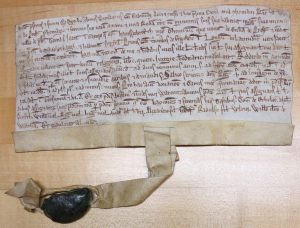
Preston Charter 7 Face. Photograph Mildred Budny.
Following our 4 previous blogposts on the group of charters from Preston in Suffolk, England, now in a private collection, we advance with further reports about them. Those blogposts focused upon 6 of the group of 8 charters. Employing the owner’s numbering system, they considered
- Charters 5 and 7: Full Court Preston and Preston Take 2
- Charters 6 and 9: Preston Charters Continued
- Charters 10 and 11: Charter the Course
(Remember, Charter 8 is missing.)
Now we turn to the last pair: Charters 12 and 13.
These are the chirographs, with wavy upper contours made to match. Both documents are dated, like Charters 9–11, but those earlier charters belong to the reign of King Edward II (reigned 1307–1327), during which reign they were spaced at 4-year intervals. Charters 12 and 13 stand more than a century apart from those and from each other. Both retain their wax seals, in full or in part.
A wavy contour:
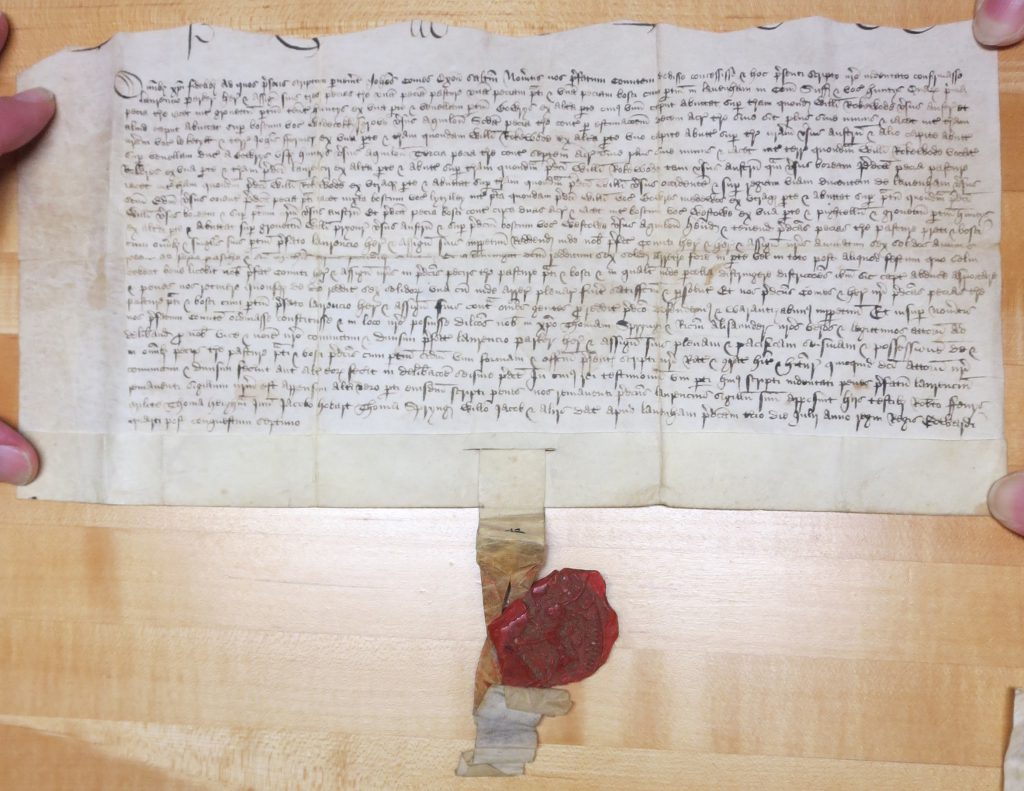
Preston Charter 12 Face with Seal. Photograph Mildred Budny.
The Group of Preston Charters
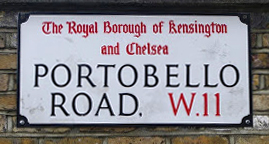

Church at Preston St Mary. Photograph by Andrew Hill via Wikimedia Creative Commons
The present owner purchased the Preston group as a group, amounting to 9 documents, in the 1980s in London, probably in the Portobello Road, a renowned location of markets and shops of many kinds, including used goods, curiousities, and antiquities.
[Update: Now we know that his first 2 purchases of English documents were of single documents: “one Ric. II” and “the other Edw. IV”. Then came the rest. On those first 2, now see More Light on English Charters.]
The group has a consecutive series of modern Arabic numbers, running from 5 to 13. The individual number is entered in black ink at the top left corner of the dorse (or back) of each document.
Of that original group, only 8 survive in the collection, because Charter 8 went missing after a class some years ago, considerably before the group came into our view. Consequently, we know now only of Charters 5–7 and 9–13.
In our series of blogposts on the Preston Charters, Charters 5 and 7 figured in our first 2 blogposts, with an introduction, photographs and descriptions, transcriptions and translations of their texts, and some observations about their characteristics and contexts (Full Court Preston and Preston Take 2). Next, Charters 6 and 9 took the stage (Preston Charters Continued). Then Charters 10 and 11 came forward to Charter the Course.
Now we complete the course with Charters 12 and 13. Each carries the regnal year of the sovereign, but a different sovereign in each case: Edward IV and Elizabeth I.
The Lay of the Land
Within the group, each document has a mostly blank dorse, but for the owner’s inventory numbers in black ink and the sparse medieval or later docketing inscriptions. The face of each document is filled with the text of the transaction, laid out in a single column of long lines. The numbers of lines vary between 9 (Charter 9), 12 (3 charters), 13 (2 charters), 14 (Charter 11), and 16 (Charter 5) lines.
Each document has a forward-facing fold at the bottom of its face. Each has a pendant tag, comprising a narrow strip or tail of vellum, to hold a seal. Some documents retain their wax seals, or parts thereof (Charters 7, 12, and 13). One (Charter 5) has a cloth pouch to protect the seal — however, now lost. At least 1 of the vellum tags (Charter 11) comprises a reused strip of already-written vellum. The tags on some documents (Charters 6 and 9–11) appear to have no traces of wax, so as never to have received seals. One tag reuses a discarded strip of already-written vellum (Charter 11).
The documents in the set exhibit certain differences. 5 of them have more-or-less rectangular shapes, wider than tall.
Charters 12 and 13 have rippled upper edges, corresponding to the chirographic method of producing an interlocking, and thereby identifiably identical, set of charter-plus-copy (or multiple copies) for distribution to the different parties to the transaction in question. For such a Chirograph, copied in duplicate (or more) upon a single sheet, the cut between them takes the form of a wavy edge; in Charter 12 it runs through an enlarged and spaced word — perhaps the Latin word chirographum in some form, as customary? — to allow the copies to be matched physically as a safeguard against forgery.
The Latin chirographum, cierographum, or cyrographum derives from the the Greek χειρόγραφον, meaning “handwritten”. Many medieval specimens survive, often as one or other instance of the original set. Sometimes an uncut sheet survives to demonstrate the process before the final cuts. As here:
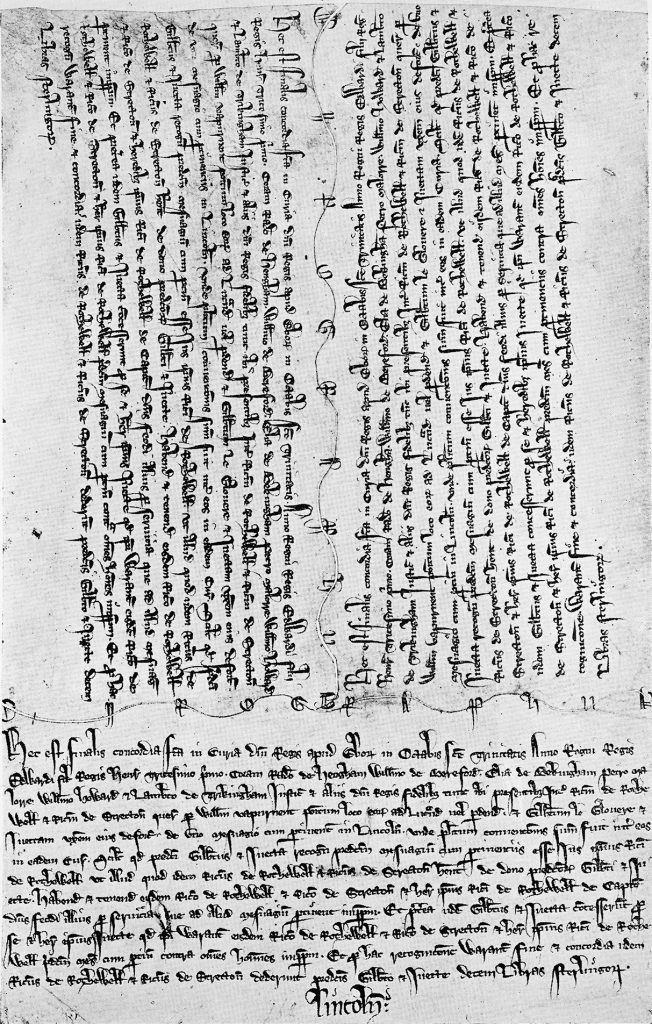
Final concord on land in Lincoln dated 31 Edw. I (1303). Lincoln, Muniment Room of the Dean and Chapter of Lincoln, “Dij, 78/I, nos. 94 and 95”. C. W. Foster, Final Concords of the County of Lincoln, vol. 2 (1920), frontispiece. Image via Wikimedia Commons.
This is an uncut, and presumably undistributed, document of “final concord”, or “fine of lands”, in the County of Lincoln, written out in full and dated to 9 June 1303 . Separated by a wavy line, the two vertical blocks of text are duplicate copies, designed for the 2 separate parties. The bottom portion (called “the foot of the fine”), would be enrolled by the court so as to serve as a record of the settlement. Drawn up on a single sheet of parchment, the whole document would function as a chirograph, to be cut with a wavy line across words (here, CIROGRAPHUM) to show proof that the original pieces were part of the same document. (More information about this phenomenon.)
Following this convention, we are entitled to expect that one or more “duplicates” of Charters 12 and 13 might perchance survive elsewhere, according to the directions of their distribution.
Group Portrait
With the full group displayed for examination, we offer their photographs from the back and the front. These group portraits demonstrate at a glance the varied sizes and shapes of the different charters, their styles of presentation, the shapes of their pendant tags, and the presence or otherwise of seals attesting to their authentication.
Seen from the Dorse
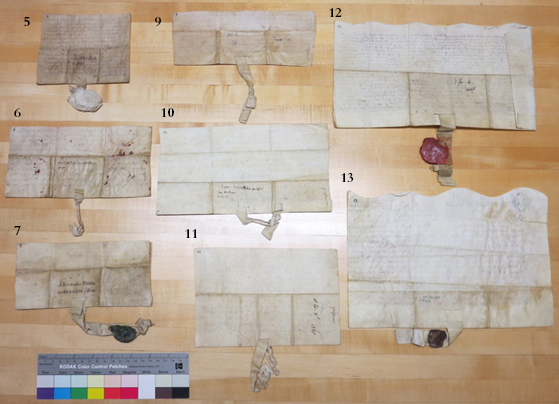
Preston Charters Dorses. Photograph Mildred Budny.
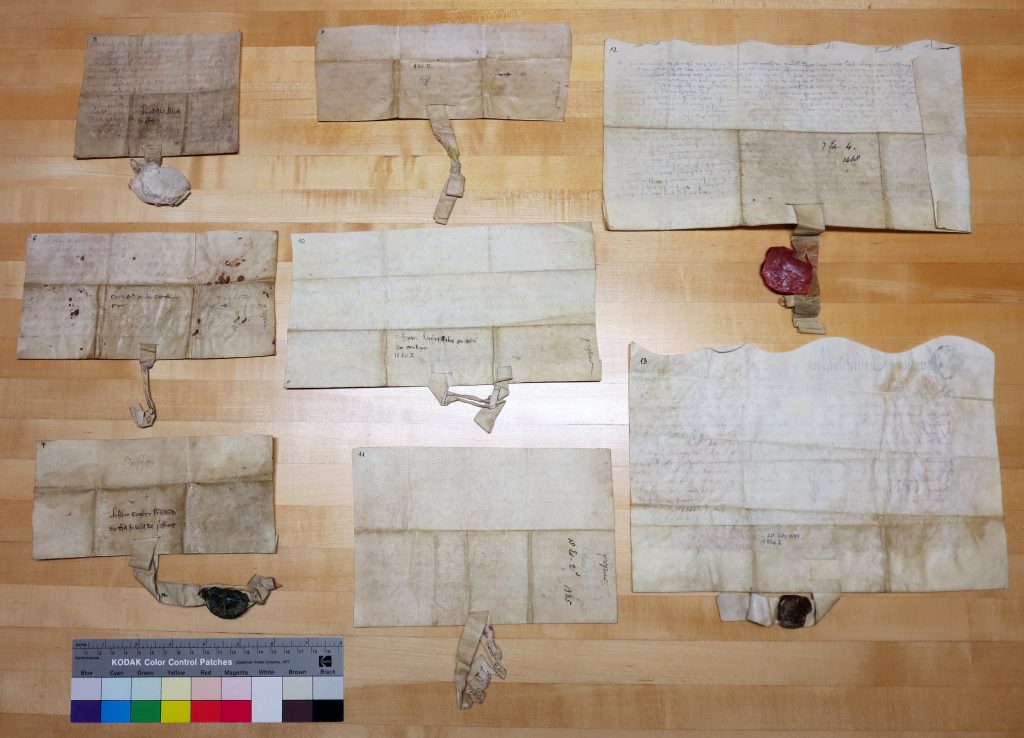
Preston Charters: Dorse with Guide. Photograph Mildred Budny.
Seen from the Face
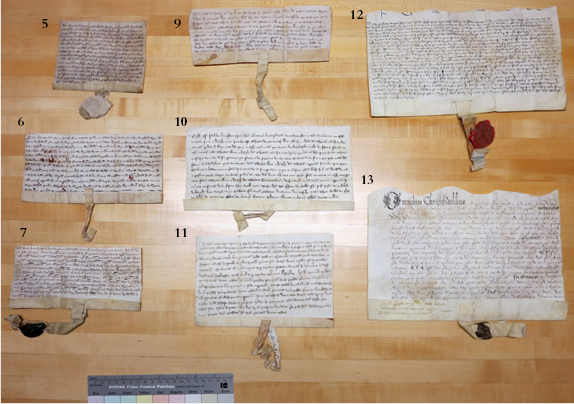
Preston Charters Faces. Photograph Mildred Budny.
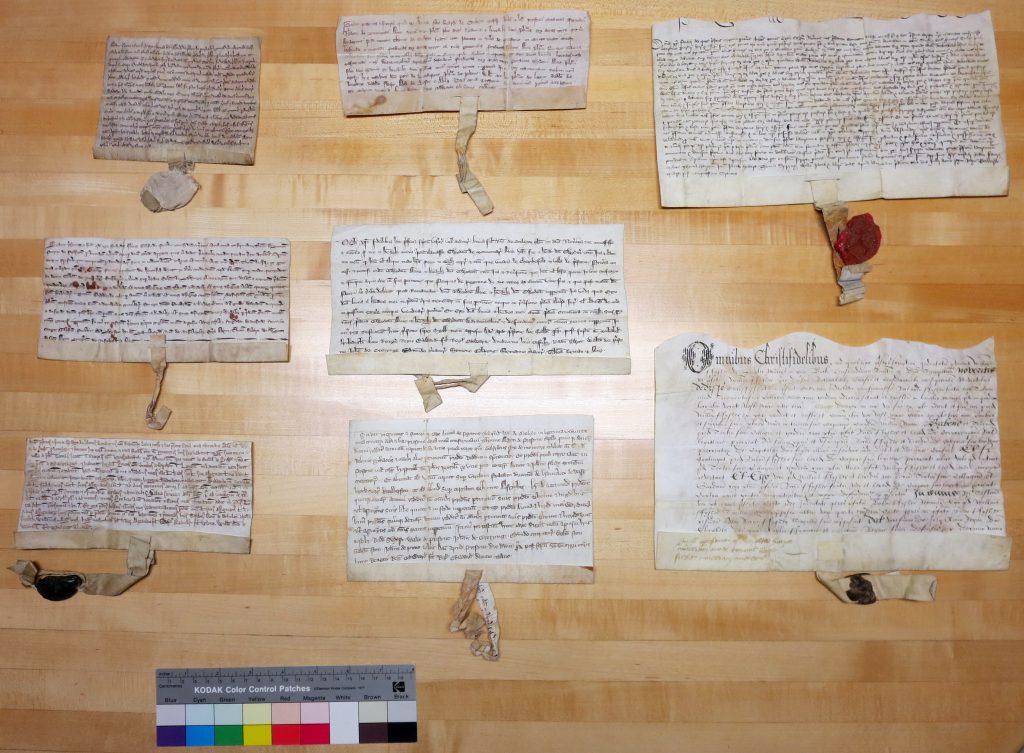
Private Collection, Group of 8 Preston Charters: Faces Forward. Photograph Mildred Budny.
Folds, Tags, Seals, and More
In preparing each document, as customary for such materials, the more-or-less rectangular sheet of vellum was folded horizontally once near the bottom, producing a flap or fold which turns inward to the side of the leaf intended to carry the text — usually the flesh side of the skin. In some cases, the upper edge of the fold hides part of the last line of text. Sometimes there is discarded writing within that fold, sometimes not. Around the flap, more or less at its center along the bottom edge of the document, a narrow strip of vellum is laced through a pair of horizontal slits (made across the flap and in the foldline) to double back upon itself and form a looped or tied tail, or tag. Sometimes this strip carries a seal of colored wax impressed or pressed in some way onto its course. In some cases, the seal survives to some extent (Charters 7, 12, and 13). One case (Charter 5) retains the old, and perhaps original, cloth pouch designed to protect the seal, but the seal itself has disappeared following its removal through one or other hole in the cloth at both the top and bottom.
The patterns of fold-lines and stains on each document demonstrate that, after completion with their written and attested texts, the single sheets were folded into smaller, block-like units, in which they were stored for a considerable period or periods of time. Mostly the sheets were folded horizontally once or twice, and then vertically into thirds, forming flaps to be turned over, one after the other, and presenting as the front of the unit the centered block at the base of the document, from which extends the vellum tail, with an optional seal. Brief docketing inscriptions are written in ink on the dorse, within that centered block and/or elsewhere.
One by One
Charters 5–11
Our earlier blogposts considered
- Charters 5 and 7 as a pair: Full Court Preston and Preston Take 2
- Charters 6 and 9 as a pair: Preston Charters Continued
- Charters 10 and 11 as a pair: Charter the Course
Among them, 3 charters are undated, while 3 carry dates within the reign of Edward II
- Charter 9: 8 Ed. II (8 July 1314 – 7 July 1315)
- Charter 10: 11 Edward II (= 8 July 1317 – 7 July 1318)
- Charter 11: 18 Edward II (= 8 July 1324 – 7 July 1325)
Charter 8 is missing.
Charters 12–13: You Are Here
Like Charter 10, both these charters begin with the phrase Omnibus Christi fidelibus (“To all the faithful in Christ”), directed to a religious community far and wide. This approach differs from the invocation of the other charters in the Preston group, Sciant presentes et futuri (“Let all present and future persons know”), intended for any of those present, now and in the future.
Charter 12
“Third Day of July” in 7 Edward IV (= 4 March 1468 – 3 March 1468)
3 July 1468
Edward IV of England (1442–1483) was King of England twice, from 4 March 1461 to 3 October 1470, and again from 11 April 1471 until his death on April 9, 1483. Within his Regnal calendar, his Year 7 spanned 4 March 1467 – 3 March 1468.
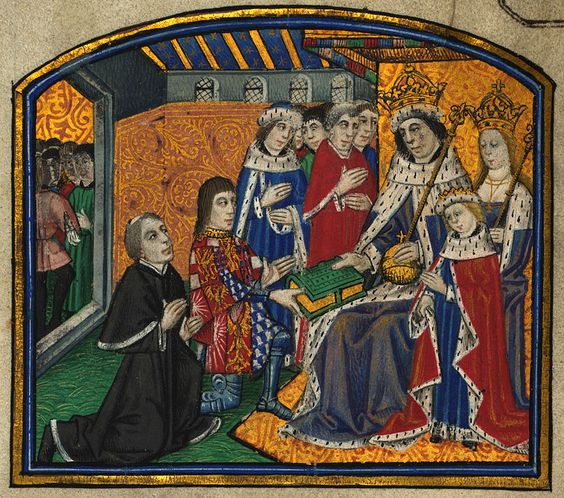
London, Lambeth Palace Library, MS 265, presentation scene. “Dictes and Sayings of the Philosophers”, the first printed book in the English language, translated by Anthony Woodville, 2nd Earl Rivers, and printed by William Caxton. Here Rivers presents the book to Edward IV, accompanied by his wife Elizabeth Woodville and son Edward, Prince of Wales. Image via Wikimedia Commons.
Dorse
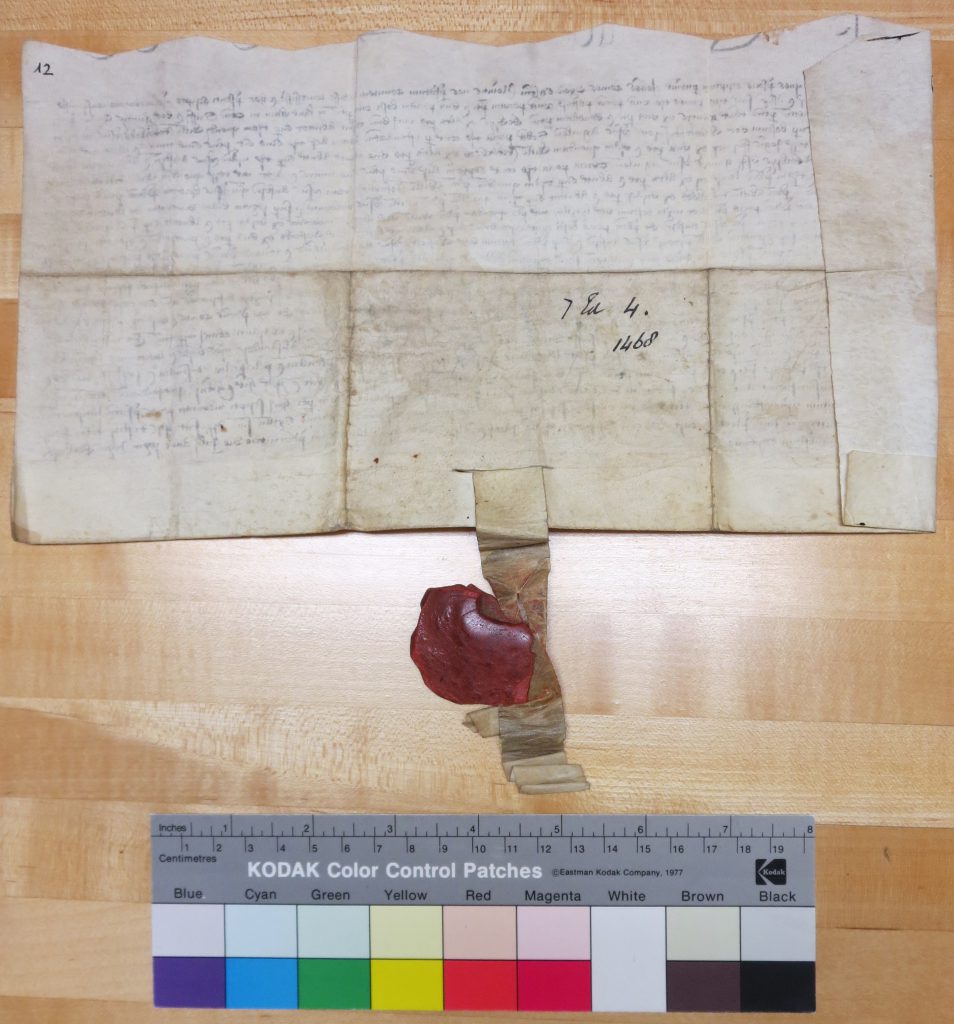
Preston Charter 12 Dorse with Seal. Photograph Mildred Budny.
The inscriptions on the dorse comprise modern entries in ink: the owner’s inventory number at the top left and the note of the date of the charter, reckoned in regnal years, and converted to “1468”. At the right-hand side of the dorse, an uneven vertical fold turns back from the face, reducing the apparent width of the document.
Face

Preston Charter 12 Face with Seal. Photograph Mildred Budny.
The dating clause stands at the end of the text. Datum . . . tertio die July Anno regni Regis Eadwardi / . . .
Tag and Lifted Flap
There appears to be no script in the interior of the foldline. The firm lacing of the tag through the fold impedes part of the view of that “gutter”. The tag retains part of the red wax seal.
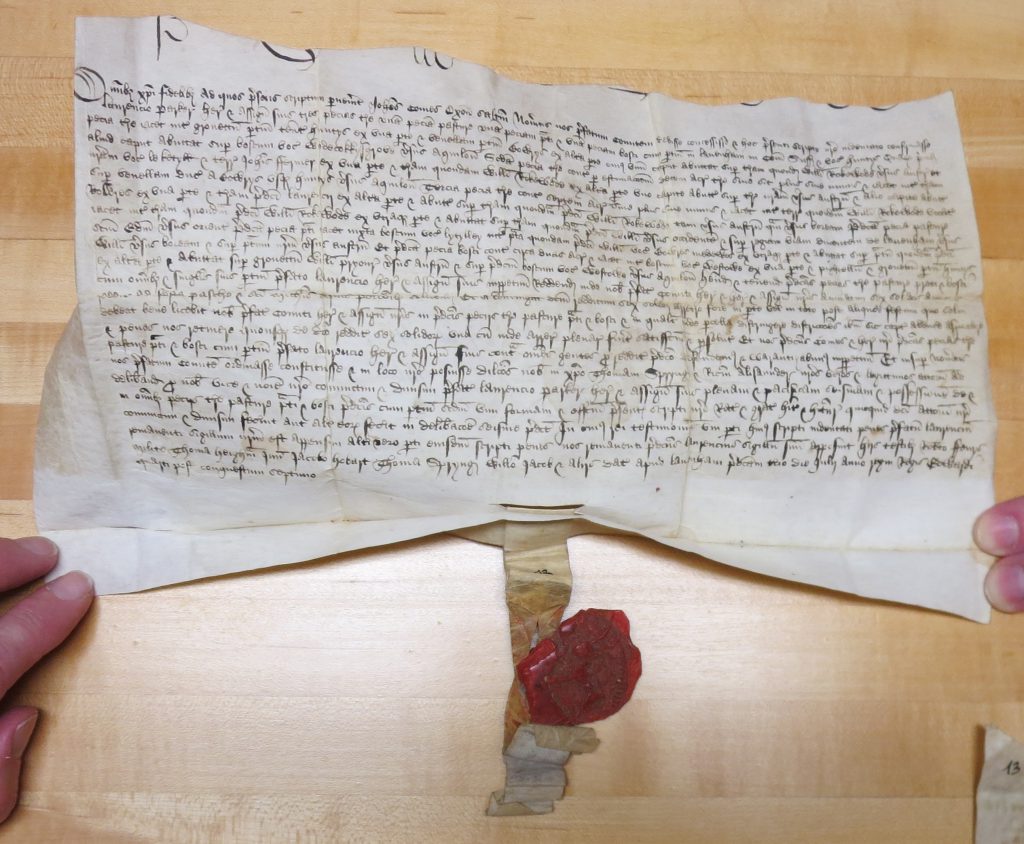
Preston Charter 12 Face with Seal and Sides of Flap Lifted. Photograph Mildred Budny.
Face
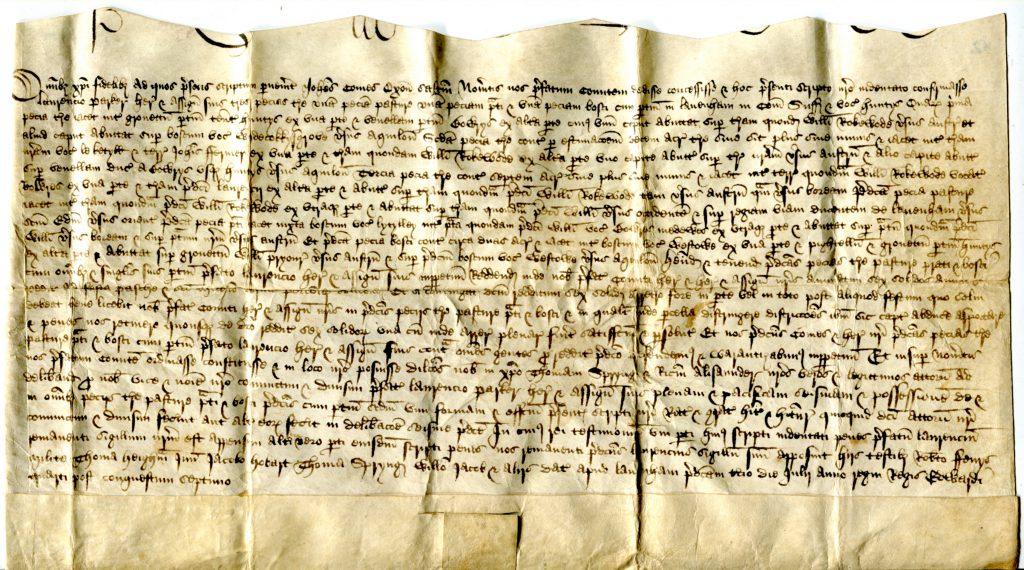
Preston Charter 12 Face.
The Seal
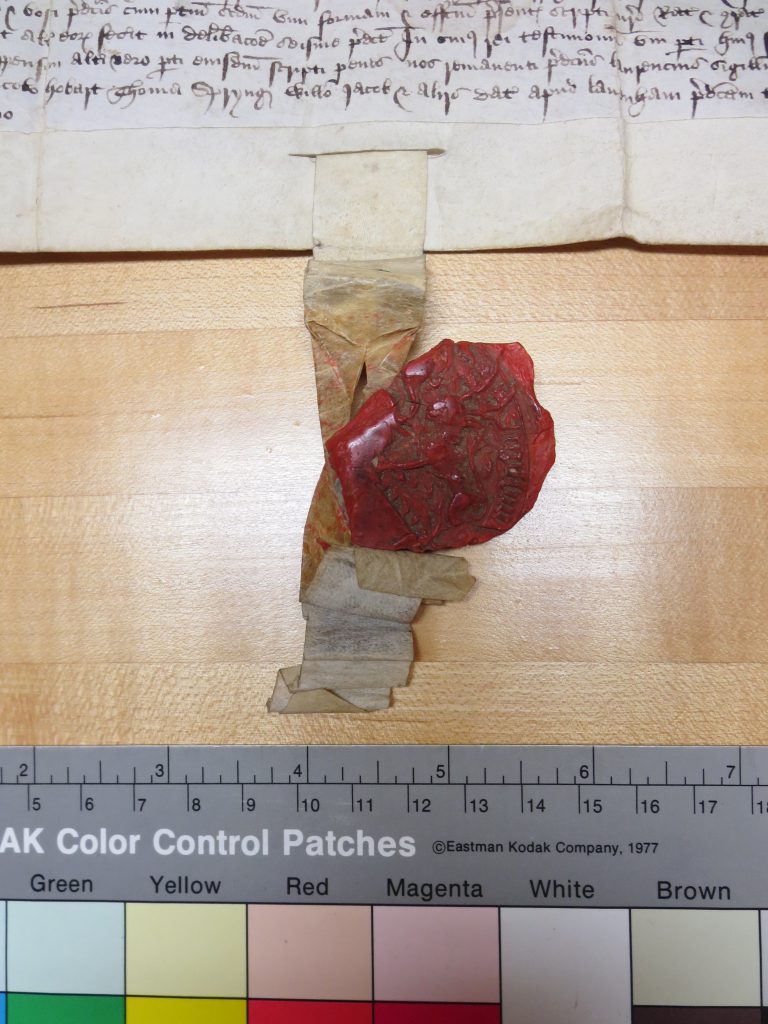
Preston Charter 12 Seal. Photograph Mildred Budny.
Up Close
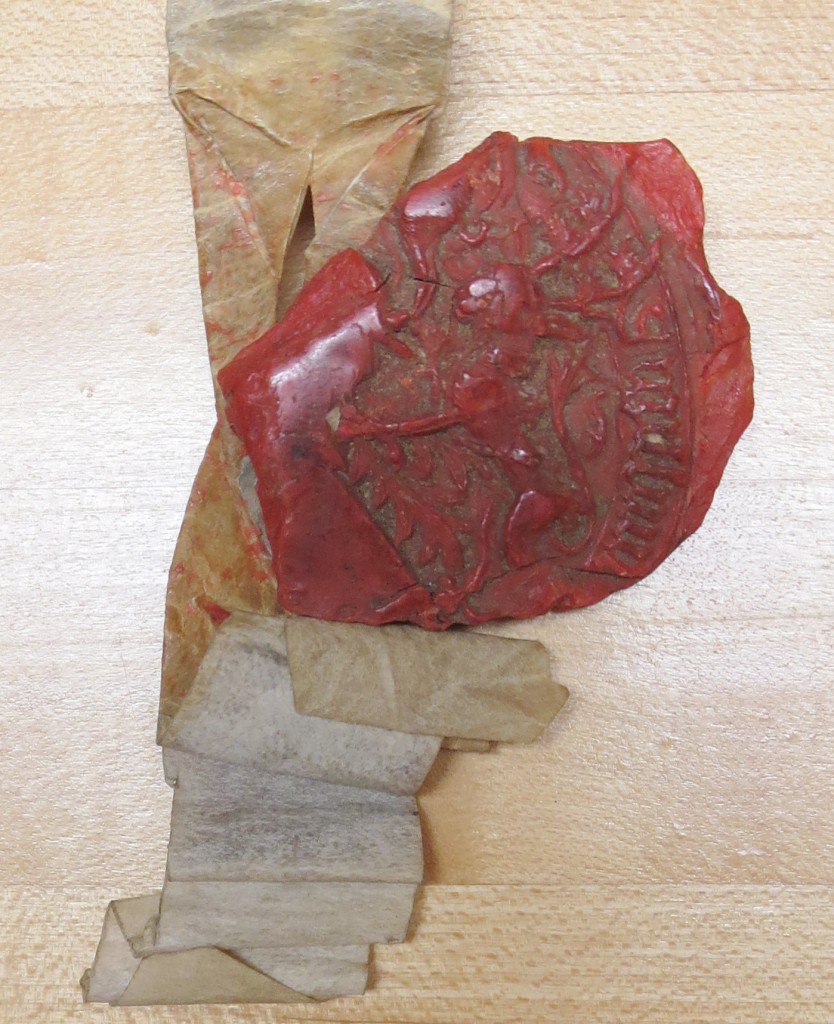
Preston Charter 12: Seal. Photograph Mildred Budny.
Upright
Viewed upright, the remnant of the seal appears to preserve most of the upper right quadrant of a circular form. Within its field of jagged foliage, a striding stag faces left, with raised antlers extending into and beyond the area of the inscribed rim, to divide the course of the inscription or ‘legend’. The inscription begins with the customary word Sigillum (“Seal”), written in full. At the stag’s head level, there appears the hindquarters of a smaller running creature with raised, hook-like tail.
Perhaps somewhere there survive(s) one or more other impressions. and/or the seal matrix, so that the full design might return to view.
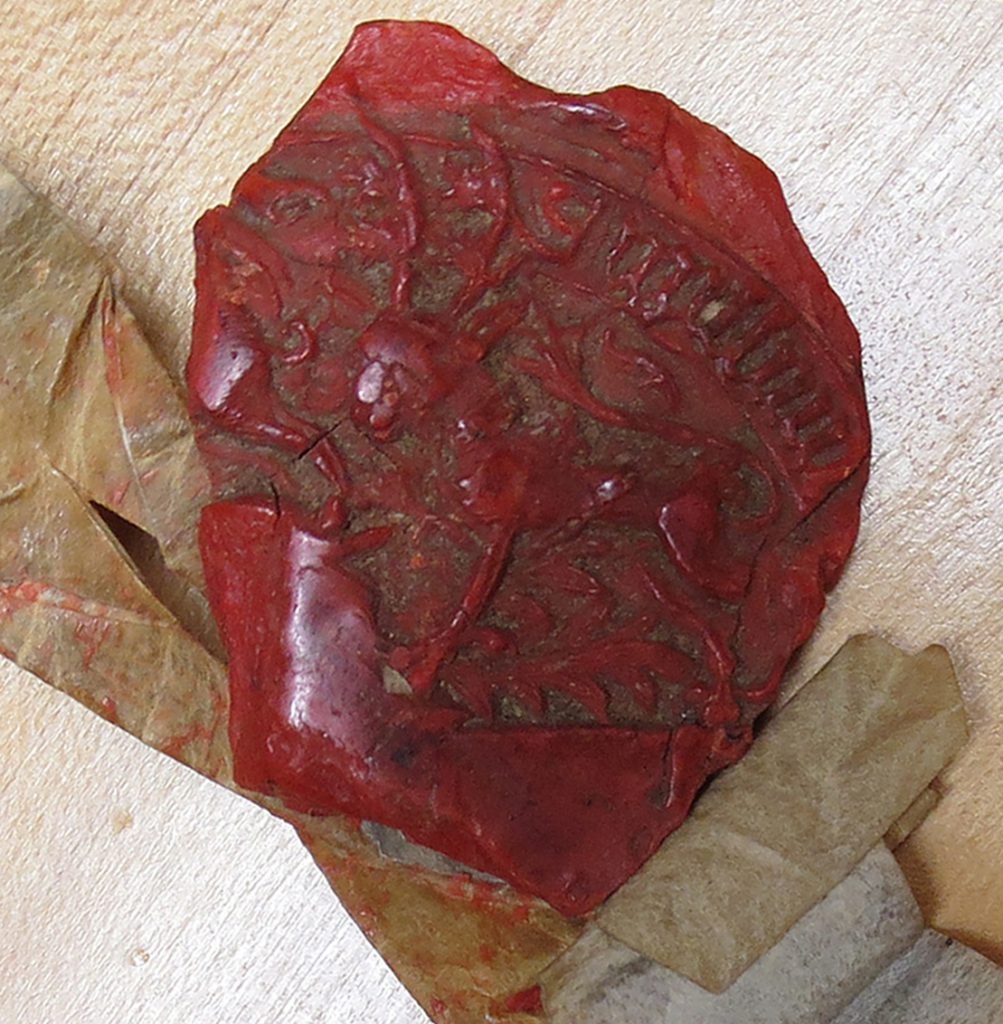
Preston Charter 12 Seal Upright. Photograph Mildred Budny.
*****
Charter 13
“20th Day of July” of 19 Elizabeth I = 20 July 1577
By William Psysher
Elizabeth I of England (7 September 1533 – 24 March 1603) reigned as Queen of England and Ireland from 17 November 1558 until her death on 24 March 1603.

London, National Portrait Gallery. Queen Elizabeth I of England in her coronation robes. between 1600 and 1610 copy of a lost original of circa 1559. Image via Wikimedia Commons.
Dorse
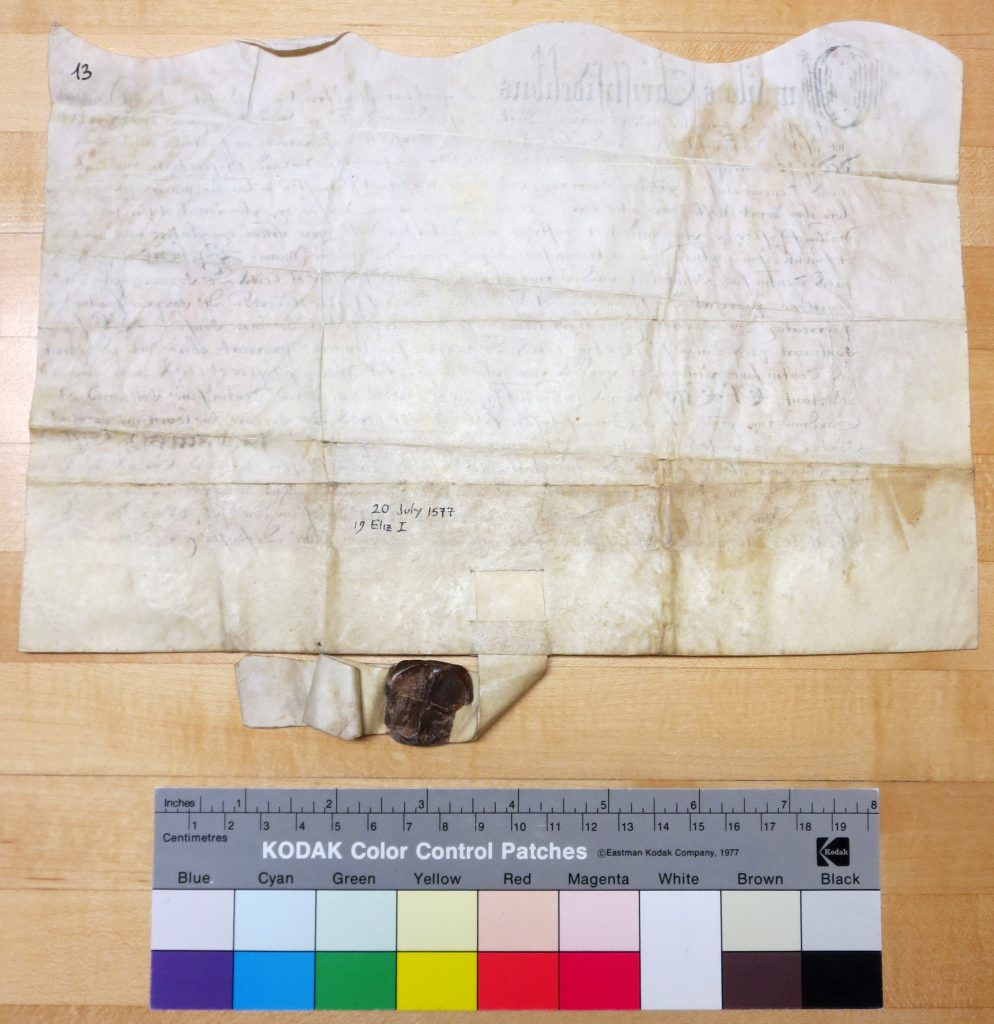
Preston Charter 13 Dorse. Photograph Mildred Budny.
Docketing
The dorse carries only the owner’s inventory number at top left and a pair of modern inscriptions in ink offset to the left at the lower center. They note the regnal year and day: “20 July 1577 / 19 Eliz I”.
Face with Seal
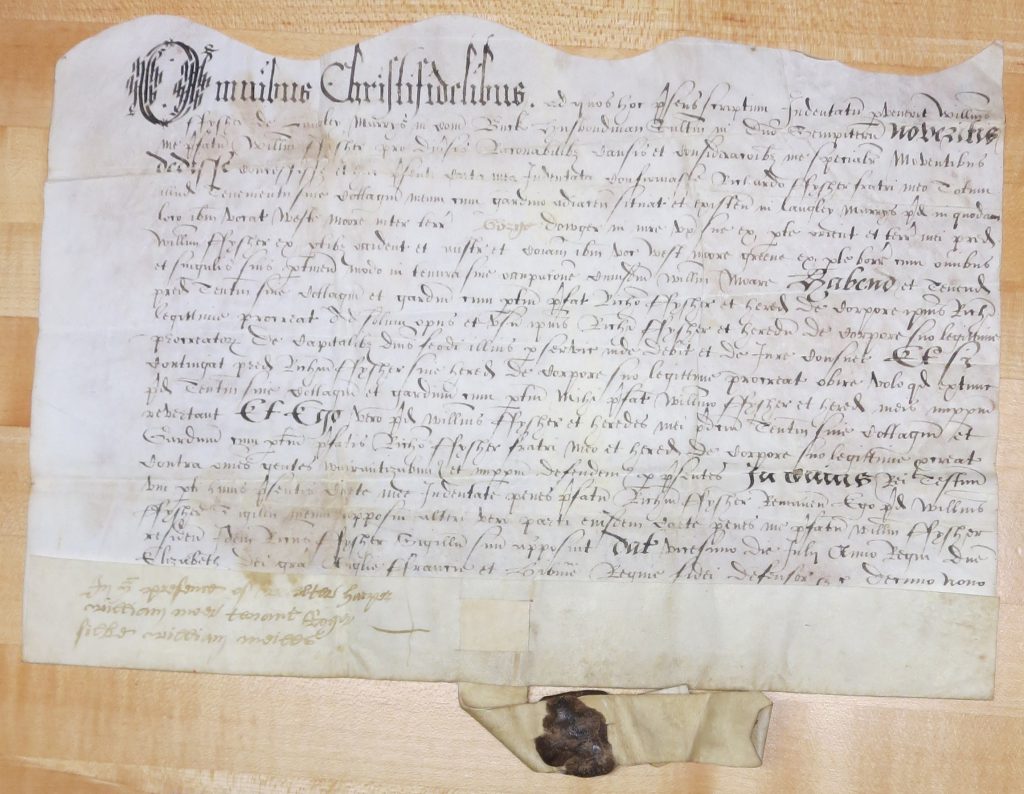
Preston Charter 13 Face. Photograph Mildred Budny.
The dating clause rounds out the charter: Datum vicesimo die July Anno Regni Domina Elizabeth dei gratia . . .
The transaction occurred less than halfway through the queen’s long reign.
Face

Preston Charter 13 Face.
Lifted Flap
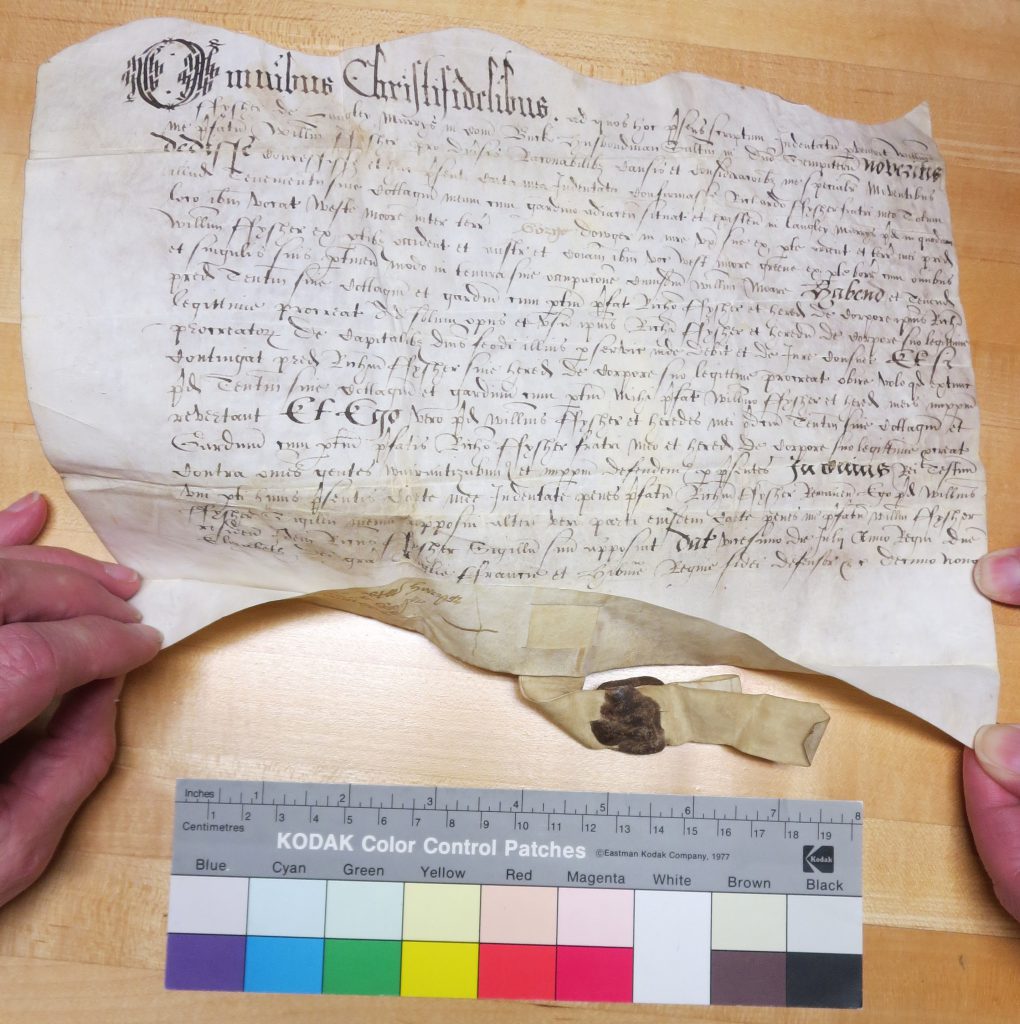
Preston Charter 13 Face with Lifted Fold. Photograph Mildred Budny.
The interior of the foldline is blank.
Inscription on the Fold
Accompanied by a large cross-shaped mark, a 3-line inscription in light brown ink by an early modern hand on the left-hand third of the exterior fold offers a note on the contents.
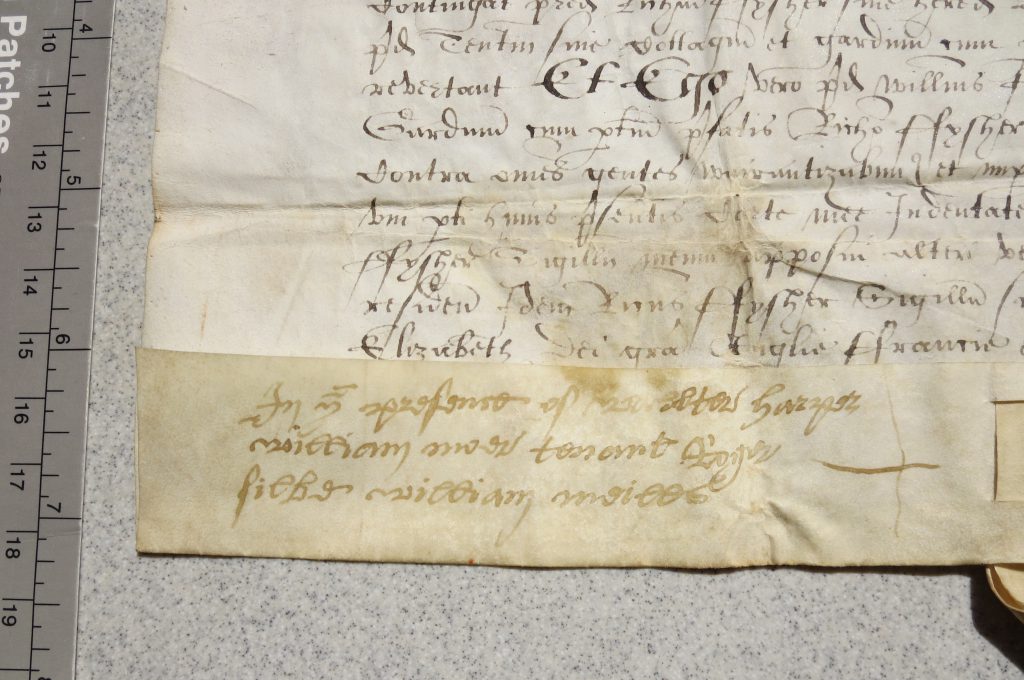
Preston Charter 13 Face Detail with Front-facing Left-hand Side of Flap. Photograph Mildred Budny.
Seal
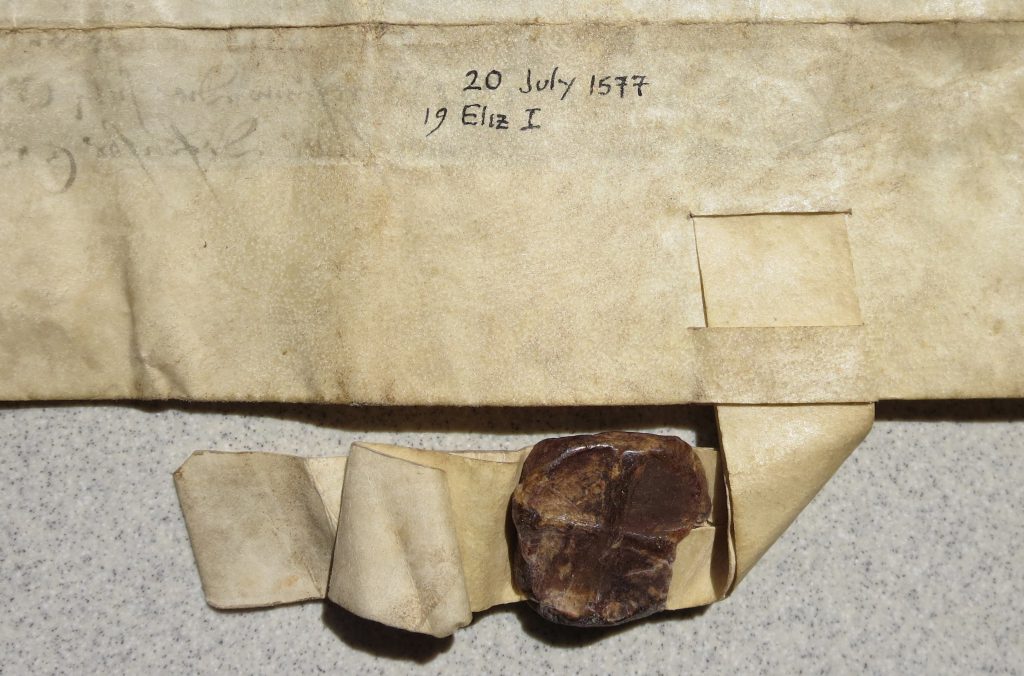
Preston Charter 13 Dorse Detail with Tag and Seal. Photograph Mildred Budny.
The wordless seal, formed of brown wax, presents a simple cross-shaped motif within a more-or-less circular rim.
*****
Next stop: More discoveries for other bodies of material. See the Contents List for this blog.
*****
